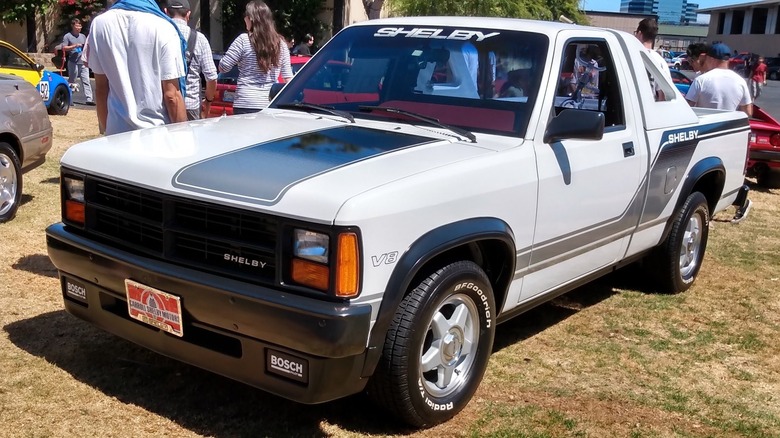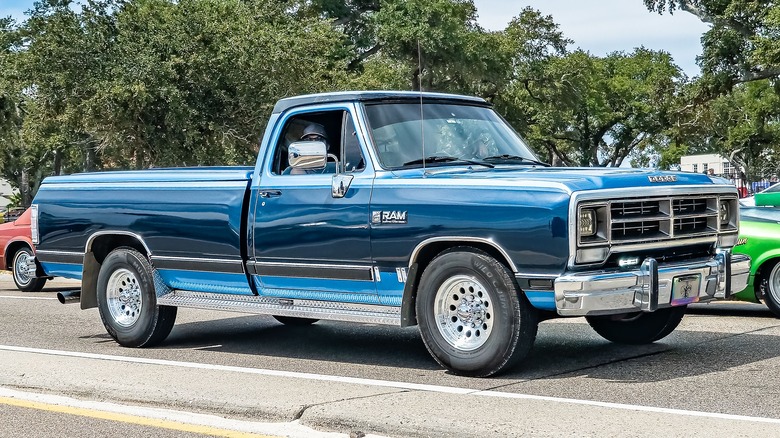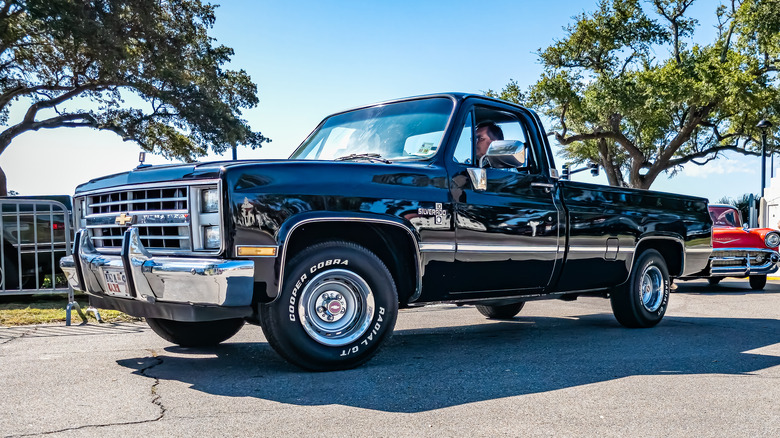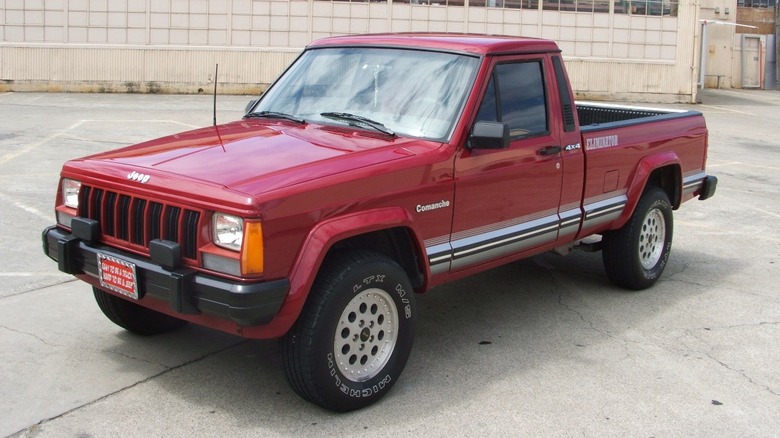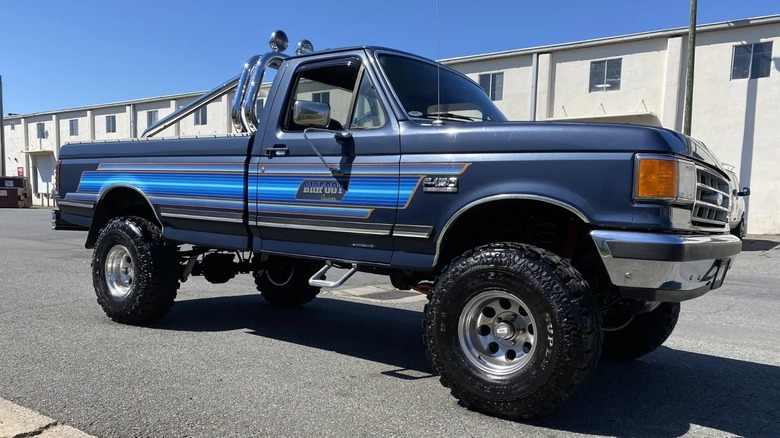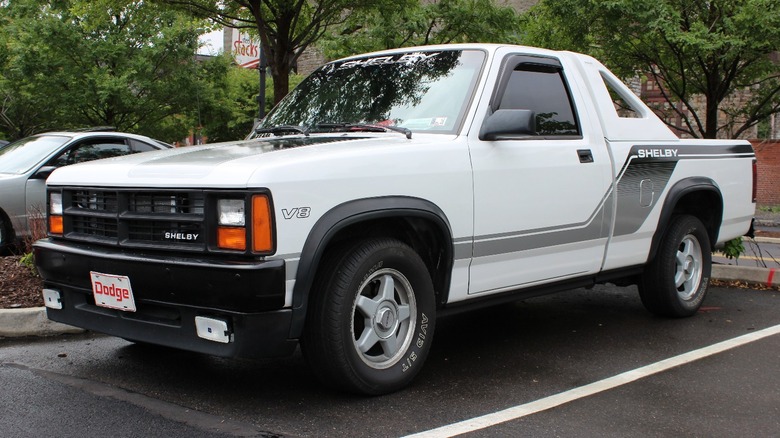5 Of The Coolest Trucks From The '80s (And What They're Worth Today)
By 1983, the "malaise era" of emissions-choked, lethargic, and underpowered American cars had come to an end, largely as a result of the Big Three U.S. carmakers innovating their way around strict emissions regulations. Electronic fuel injection, multi-valve cylinder heads, forced induction, and variable valve timing brought power back and fun with it. American icons like the Chevrolet Corvette, Ford Mustang, and Pontiac Trans Am rose from the ashes with the most performance on offer since the introduction of the 1970 Clean Air Act. While the rebirth of vaunted American sports cars was exciting, the '80s were truly the decade of the pickup.
Pickup trucks have been popular since the years following World War I, but the '80s were a time of experimentation, innovation, and improvement for both new truck lines and legacy models. From the first-generation Cummins Ram that kickstarted the modern Power Stroke vs. Duramax vs. Cummins showdown to the Ford F250 Bigfoot monster truck tribute, the 1980s were full of both historically significant trucks and ones that perfectly encapsulated the essence of the decade. Without the innovations to consumer pickups that arrived in the 1980s, we might not have the turbo diesels, sports trucks, or ludicrous special editions that we know and love today. Likely due to a combination of nostalgia and beloved characteristics, most of the coolest trucks of the 1980s hold their value well and still fetch high premiums to this day.
[Featured image by DestinationFearFan via Wikimedia Commons | Cropped and scaled | CC BY 4.0]
1989 Cummins Ram
In the years prior to 1989, Dodge's D-Series pickups were dying a slow death. Chrysler was lagging far behind the competition in the mid-1980s, as Ford and Chevrolet continued to innovate and refresh their leading pickup options, while Dodge stuck to the status quo. Chrysler was especially falling behind with their diesel offerings. Ford offered a 162 horsepower 6.9-liter International Harvester diesel in the F-Series, and the Chevy C/K could be ordered with a 130 horsepower 6.2-liter GM/Detroit Diesel. By comparison, the 105 horsepower Mitsubishi-sourced inline-six diesel offered in the D-Series, for 1978 only, was a joke. That changed in a big way in 1989 with the introduction of the first-gen Cummins Ram.
1989 marked the first year of Chrysler's partnership with famed diesel manufacturer Cummins, which produced a new 5.9-liter Cummins for use in the first-generation Ram Pickup. Dodge renamed its D-Series truck lineup to "Ram" in 1981 in an effort to revitalize the struggling D-Series, and the 5.9-liter Cummins was a key factor in the truck's 180-degree turnaround. Compared to the diesel engines offered by Ford and Chevy, the 5.9 Cummins was a cutting-edge powerhouse. Its use of a direct-injection fuel system and a Holset H1C turbocharger revolutionized the consumer diesel engine and immediately made the first-gen Cummins Ram the benchmark for turbo diesel trucks. In an effort to compete with Chrysler, Ford and Chevy developed their Power Stroke and Duramax turbo diesel engine series respectively, leading to a torque war that continues to this day.
Being the progenitor of modern turbo diesel, first-gen Cummins Rams are not only historically significant but also beloved for their simplicity and durability. As a result, they hold their value well, with the average price for a decent example being $17,000 according to Hagerty.com.
1987 Chevrolet R/V
The third-generation Chevrolet C/K, produced between 1973 and 1987, is legendary in every sense of the word. The roots of the "square-body" can be traced back to the early 1960s, when the first generation C/K took the reins from the Task Force series as GM's premier truck offering that blended all-out utilitarianism with everyday comfort. The third generation C/K was a major step towards modernization for the series, utilizing a wind tunnel-designed body, computationally developed suspension components, and a smorgasbord of then-new creature comforts.
Upon its release, the square body was firmly ahead of the competition. Its body was created with aerodynamics in mind, mixing a brick-like geometry with rounded edges to allow air to caress it rather than impede it. Its stretched wheelbase was bolstered by a sturdier frame, which was supported by independent front suspension on rear-wheel drive C-Series trucks and revised front leaf springs on four-wheel drive K-Series models. The third-gen was also offered with a dizzying number of powertrain options, ranging from iconic big blocks, to trusty small blocks, and fuel-efficient inline-sixes. For 1987, the C/K's engine options received computer-controlled fuel injection, improving gas mileage and cold weather operation.
1987 is a highly sought-after model year for the third-gen C/K, as it was the last model year of the body style, and fuel injection made daily operation easier. Actually, R/V is a more accurate title, as GM began using the C/K designations for the GMT400 generation that year, renaming the 1987 models to R/V instead. Due to demand, second-hand values for 1987 R/V trucks are higher than average compared to earlier model-year third-gens, typically going for around $28,540 according to Classic.com.
1991 Jeep Comanche Eliminator
Jeep is a brand that needs no introduction, but some people might need an introduction to the Cherokee XJ's pickup brother, the Comanche. Jeep has a long history with trucks, starting with the Willys-Overland Jeep 4x4 pickup in 1947 which was so successful that it stayed in production for nearly 20 years. Later options including the utterly timeless J-Series and rugged Jeep CJ Scrambler made their mark in the Jeep pickup canon, but the Comanche, which arrived in 1986 was arguably the coolest.
The Comanche was built on the same platform as the XJ Cherokee, one of the most beloved Jeep models of all time. As a result, the Comanche featured many of the same praised characteristics as the SUV, including front-end unibody construction, optional full-time four-wheel drive, and Quadralink front suspension. It was offered in either short or long bed configurations and a number of different trim levels. The pinnacle of the bunch was the Comanche Eliminator, which was introduced for the 1988 model year.
In a move rare to the compact pickup market at the time, Jeep designed the Eliminator for all-out performance. It came equipped with the top-of-the-line 4.0-liter Power Tech inline-six, which put out 173 horsepower and 220 lb-ft of torque; for comparison, the competing Chevy S10 could only muster 125 horsepower from its V6 at the time. Thanks to the Power Tech, it was the fastest compact pickup of its day and provided best-in-class towing capabilities as well — truly the whole package.
Despite their pedigree and performance, only around 200,000 Jeep Comanches, and far fewer Eliminators, were built between 1986 and 1992. According to Hagerty.com, the average auction price for a 1991 Eliminator is $12,800.
[Featured image by Shharks via Wikimedia Commons | Cropped and scaled | CC BY 3.0]
1989 Ford F250 Bigfoot
How much cooler does it get than a massive, car-crushing monster truck? Honestly, not much. Ford also agreed with that sentiment, leading to the introduction of the F250 Bigfoot in 1987 which was an homage to the pickup that invented monster trucking to begin with. In the late 1970s and early 1980s, Bigfoot became a household name across the U.S. as Bob Chandler paraded his heavily modified 1974 Ford F250 around the country, bulldozing cars in publicized events. Ford became a Bigfoot sponsor in 1983, helping Chandler create purpose-built follow-ups to the original truck. By that time, monster trucking was becoming big business and Ford wanted to use the Bigfoot name to create something special in its product line.
For the 1987 model year, Ford introduced the special monster truck-inspired Bigfoot package for Ford F-150, Ford F-250, Ford F-350, and Ford Ranger models. The package offered upgraded and lifted suspension, 33-inch tires, a winch-equipped front bumper, a double-hoop roll bar, and cab-mounted roof lights. To round out the package with some visual flair, the models also received Bigfoot logos emblazoned on their sides and the original truck's signature blue and gold decals. The package itself was exceptionally rare, with FordAuthority.com claiming that only around 300 mini-monsters were built.
Unfortunately, the F250 Bigfoot was involved in a bit of controversy upon its release, as faulty cruise control modules led to multiple examples catching fire, prompting a recall from Ford. Despite the mishap, the F250 Bigfoot is a highly sought-after collector's truck and unquestionably one of the coolest trucks of the 1980s, leading to high secondhand market value. Because of their rarity, Bigfoots don't come up for sale often, but one did sell on BringATrailer.com last year for $70,000.
1989 Dodge Shelby Dakota
Carroll Shelby's legacy is so deeply embedded into the fabric of American car culture that he even gave Enzo Ferrari a run for his money in terms of influence and name recognition. Mr. Shelby was known for his performance cars, having played an instrumental part in developing the Ford GT40 Le Mans racer and by creating one of the most high-octane sports cars of all time, the Shelby Cobra. Having worked on multiple projects with Ford, Carroll Shelby was historically and unsurprisingly a Ford man. However, when Lee Iacocca, Ford executive and close friend of Shelby, left to spearhead Chrysler's operations in the late 1970s, he called Carroll in to spice up the Dodge lineup.
One of the most unexpected of Shelby's contributions was the Shelby Dakota, which was based on the rather boilerplate Dodge Dakota mid-size pickup. The Shelby Dakota's key feature was a 175 horsepower 5.2-liter Magnum small block under the hood, which, while not mind-blowingly powerful, made it a standout option during a time when V8s weren't a common option in midsize offerings. Outside of a standard limited-slip differential, the vast majority of the Shelby Dakota's upgrades were cosmetic, including a mild body kit, an interior touch up, unique alloy wheels, and Shelby badges adorning virtually every surface that could fit one.
While it might not sound like much, it's important to remember that the Shelby Dakota arrived on the scene four years before the Ford SVT Lightning and a decade and a half before the Dodge Ram SRT-10, making it a true trailblazer. It doesn't fetch the same prices as those other two, though, averaging an auction price of just $14,195 according to Classic.com.
[Featured image by Jacob Frey 4A via Wikimedia Commons | Cropped and scaled | CC BY 2.0]
